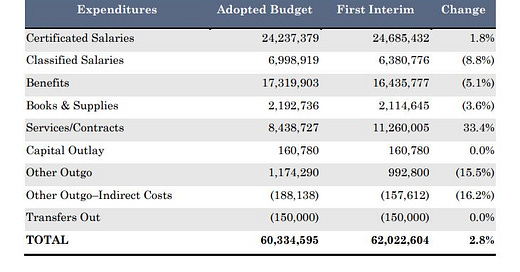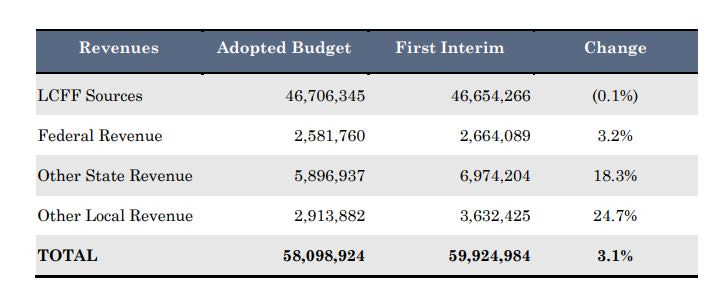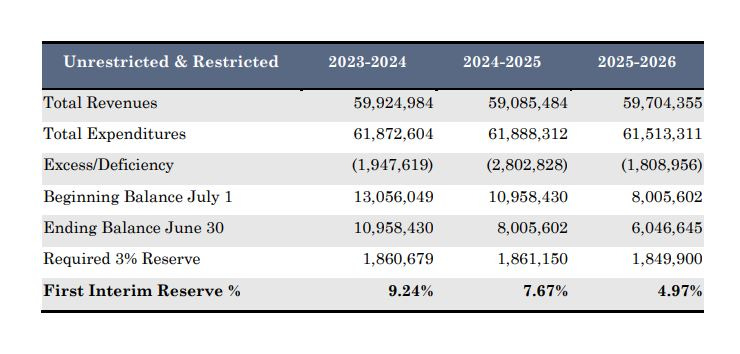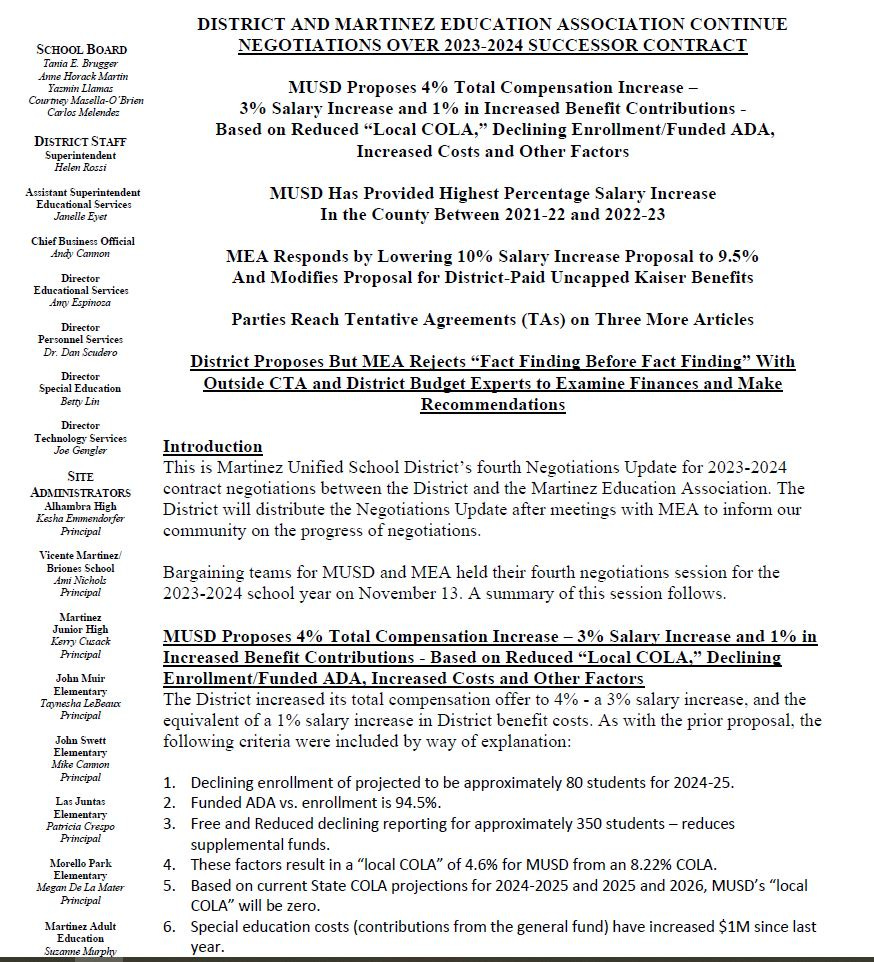MUSD Braces for Major Budget Cuts as Contract Negotiations with Teachers Union Reach Stalemate
After hiking pay 19% over past two years, district offers teachers 4% raise as projections show expenses surpassing revenues in years ahead; union files for impasse; park name reversal
Facing a long-term structural budget deficit, the Martinez Unified School District anticipates “substantial reductions in staffing, books and supplies, and contracted services to maintain adequate reserve levels as required by California statute,” according to the latest budget report that will be presented at Monday’s school board meeting.
The grim outlook comes as the district — which has increased employee salaries by 19% over the past two years — finds itself in increasingly contentious contract negotiations with the Martinez Education Association (teachers union), which has filed for what is known as “impasse” for the first time since 2018. As a result, an outside mediator likely will be assigned to try to help the two sides reach an agreement.
While the district’s overall financial situation remains healthy, according to its first interim budget report for 2023-24, MUSD is “facing multiple challenges ahead,” exacerbated by expiring COVID-19 funding from the state and federal government, diminishing attendance-relief measures, and economic forecasts projecting future cost-of-living increases in state funding to fall dramatically.
MUSD is anticipating expenses to surpass revenues by approximately $2.1 million in the current fiscal year, forcing the district to continue to eat into its reserves. The district’s reserve fund is expected to fall from $13.1 million at the beginning of this fiscal year to $11 million in 2024-25 and $8 million in 2025-26 (amounting to a 38% reduction). The district is required by law to maintain a minimum 3% general fund reserve level for economic uncertainty; current projections show its reserve level falling from 9% currently to 5% by 2025-26.
According to the budget report, those projected depletions in reserves will grow depending on the outcome of labor negotiations with the MEA and whatever salary increase percentage is ultimately agreed to.
The budget imbalance is being fueled in large part by increasing employee compensation costs stemming from the recent pay hikes coupled with declining state funding resulting from negative enrollment and attendance trends over the past several years, although there are initial indications those trends are beginning to stabilize or reverse. Nevertheless, the district is anticipating that funded Average Daily Attendance (ADA) from the state will continue to decline over the next four years.
Despite the budget challenges, the teachers union is pushing for another significant pay hike on top of the 19% in increases over the past two years — which the district says is the highest percentage granted by any district in Contra Costa County for the 2021-22 and 2022-23 fiscal years. According to an update on budget negotiations posted on the MUSD website, the MEA initially asked for a 10% increase in the 2023-24 successor contract, which it has since lowered to 9.5%.
According to a slideshow of an MEA presentation it gave at a community forum this week, the raises it received the past two fiscal years were the first ones since a 4% increase in 2018-19. It argues that the district needs to do more to make its pay scale for teachers competitive with other districts if it hopes to recruit and retain quality educators.
According to the district’s negotiations update, the union has modified its medical benefits proposal from asking the district to pay full family Kaiser coverage to paying full coverage for employees and up to one dependent, and a 25% reduction in the out-of-pocket family contribution to $137.98 per month. The district says it is slated to pay 93% of the overall costs for full family Kaiser coverage in 2024.
In arguing for a more generous contract, MEA has pointed to larger salary increases offered by surrounding districts this year and an 8.22% cost of living adjustment (COLA) in funding enacted by the state for 2023-24. But the district has countered that the “local” COLA rate, when accounting for the decline in funded Average Daily Attendance (ADA) facing MUSD, is now 3.04%.
And things are projected to get worse, with the district anticipating a negative local COLA rate for 2024-25 if the “the overall COLA is reduced as projected.”
A spreadsheet compiled by Transparent California showing the total pay and benefits for every teacher in MUSD in 2022 can be viewed at the following link (not all teachers were employed for the entire year):
I didn’t have a chance to do a thorough comparison of MUSD salaries with other nearby districts based on the Transparent California data (2022 salary data are not available for many districts), but here is a snapshot of the highest 2022 base pay for a teacher in a few local districts, including Martinez (which is by far the smallest of the districts compared in terms of student population and the number of teachers employed):
MUSD: $113,322
Pittsburg Unified: $125,035
Mt. Diablo Unified: $146,862
Antioch Unified: $133,031
West Contra Costa: $135,668
It’s not possible to perform an accurate comparison of average annual salaries among these districts because the Transparent California database includes teachers who were only employed for part of the year in question, skewing their pay figures. Also, I’m unable to compare MUSD salaries with the nearby district that most resembles it in size and socio-economic status, Benicia Unified, because 2022 data was not available for that district.
Another caveat: A teacher’s total pay includes various factors beyond base pay, most notably district funding of their medical benefits. These can vary significantly from district to district, and the amount of compensation for benefits can also vary dramatically between individual teachers in a given district depending on how many family members they have on their plan.
The two sides are currently far apart in negotiations, with the district offering a 4% hike in total compensation (3% in salary and 1% in increased benefit contributions). The district’s budget report says that health and welfare cost increases for Kaiser Family Coverage are anticipated to increase by 13% this year, with steady growth of 5% over the next two years.
In an attempt to facilitate an agreement given how far apart they are, the district says it proposed to the MEA that each side bring in its own budget experts “who would receive all relevant budget documents and any information proposed by either party to be included.” The budget experts representing each side would confer as they see fit and report findings and recommendations. The union rejected this proposal, according to the district, and filed for impasse.
In response to an inquiry from me this week on the next steps in labor negotiations now that the MEA has filed for impasse, Superintendent Helen Rossi responded with the following explanation:
Impasse means that a request for action is filed at PERB (Public Employee Relations Board) and that "action" is to request a mediator. Since MEA filed for impasse, staff at PERB, typically an attorney, will make a determination if the filing should be "certified." In order for the "action," or mediation, to move forward, PERB has to certify that we are in essence at a stand still in negotiations. The MUSD received official notice last evening and should PERB certify the request, a mediator will be assigned.
There are some glimmers of good news in the first interim budget report prepared by MUSD Chief Business Official Andy Cannon:
Current attendance figures show that enrollment is flat for this year, signaling that declining enrollment may end in the short term.
The Average Daily Attendance (ADA) percentage is trending higher than the last year’s 93.6%.
Total revenues have increased 3.1% from the budget adopted in June, while total expenses have increased by a slightly smaller 2.8%.
But with California facing a projected $68 billion budget deficit, it’s unlikely the state will be coming to the rescue with increased funding streams anytime soon.
There may, however, be a local lifeline down the road for the district when the City Council presumably adopts its revised Housing Element on Dec. 20 and submits it for approval to the state. Years of abysmal failure in meeting state-mandated housing targets has helped lead to a steady decline in the city’s (and county’s) population, which has also impacted school district enrollment and funding. With the state now forcing cities to put real teeth in their housing plans to stimulate development, particularly of affordable homes, as the housing crisis grows worse, there’s a chance that Martinez’s new Housing Element will have a two-pronged positive effect on district finances and quality of education.
One, more housing would likely stem the population slide, which would bolster MUSD’s enrollment and, by extension, its ADA funding. Additionally, if the Housing Element makes a true dent in increasing the city’s affordable housing stock, it should help the district to recruit and retain quality teachers and other employees without having to continually resort to the steep, potentially budget-busting pay hikes needed to fill essential positions and address the local cost-of-living challenges for people who work here.
According to a 2022 report by Stephen Levy of the Center for Continuing Study of the California Economy:
For many years, the prevailing narrative about housing and school enrollment has been that more housing will create financial and other pressures on school districts. With enrollment declines impacting many districts, additional housing could help these districts avoid financial, staffing and facilities challenges.
But there are big ifs, given that the Housing Element is merely a roadmap for future housing development and provides no guarantee that home builders, or others with the capacity to add housing units, will take advantage of its provisions. Its potential to address the types of financial challenges weighing on the school district, and the city, will largely depend on whether city leaders and the community as a whole make housing a true priority in the years ahead and invest the time and energy necessary to make the goals of the Housing Element a reality.
For now, the current budget situation will dominate the school board’s attention on Monday. A budget workshop is scheduled at 4:30 p.m. at the district offices at 921 Susana St. in advance of the regularly scheduled board meeting at 6:30 p.m., where Cannon will present the budget update. Both meetings are open to the public.
For more information, click on the following link: https://simbli.eboardsolutions.com/SB_Meetings/SB_MeetingListing.aspx?S=36030321
Park name reversal
The City Council rejected the suggested name of Karkin Park for the planned park on Pine Meadow Drive at Wednesday’s City Council meeting, after lengthy public comment and discussion. The council sided with the majority of public comment that pushed for Pine Meadow Park to be the name, given that Pine Meadow is the name that the area has long been known as from the time that it housed Pine Meadow Golf Course and had received significant community support during the naming process.
The Parks, Recreation, Marina and Cultural Commission (PRMCC) had recommended that the council name the park after the Karkin language spoken by a local tribe that resided in the Carquinez Strait during the early 1800s. The council did say it will look for opportunities to honor the Karkin language and indigenous tribe elsewhere in the city, and consult with local tribes on the best way to accomplish that.
Look for a complete report on this topic and others from the council meeting in an upcoming post.








Thank you. You have always had a good finger in the pulse of the district and this information is deep so I don’t claim to understand it all. It would be wonderful to have the unions perspective here as well so I hope they see this and respond.
But my worry is not looking back to the LACK of adequate wages prior to the 19% increase as well as the increases in health care insurance costs and cost of living. If anyone suffers from cost of living increases it is our teachers who spend their own money for supplies the school can’t supply and that parents assume are going to be provided.
We need for teachers to be able to afford to live where they work. And our county is third highest cola in the state I think.